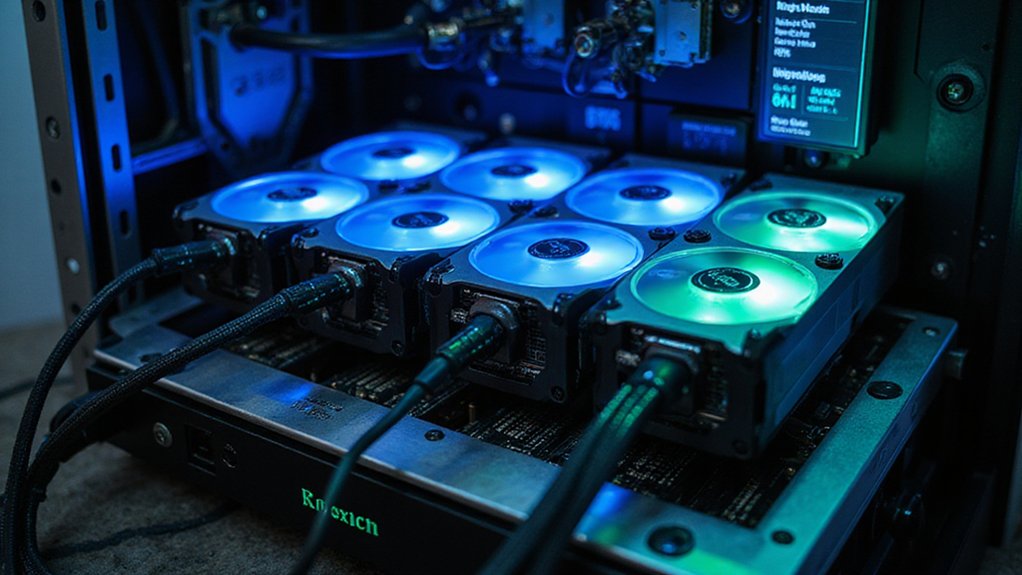For cryptocurrency mining profitability, Bitcoin remains the gold standard but requires specialized ASIC hardware, while Kaspa offers impressive returns with its GhostDAG protocol. Miners must balance electricity costs (typically the primary expense), hardware efficiency, and network difficulty—a financial trifecta that rarely aligns perfectly. Tools like WhatToMine and CryptoCompare provide essential analytics for comparing potential returns across assets. Most profitable operations now join mining pools like F2Pool rather than going solo. The deeper mechanics of mining economics reveal surprising opportunities beyond the obvious choices.

The labyrinthine world of cryptocurrency mining presents a complex calculus of profitability, where today’s lucrative algorithm might become tomorrow’s financial sinkhole.
Discerning miners navigate this volatile landscape armed with comparative analytics from platforms like WhatToMine and CryptoCompare, which offer granular breakdowns of expected returns across various digital assets.
These calculations—predicated on electricity costs, hardware efficiency, and network difficulty—serve as the bedrock for informed decision-making in an ecosystem where profit margins fluctuate with algorithmic adjustments and market whims.
Mining profitability hinges on the triumvirate of power costs, hardware performance, and network complexity—a delicate equilibrium constantly recalibrated by market forces.
Despite its formidable barriers to entry (not least the specialized ASIC hardware required), Bitcoin maintains its position as the gold standard of mining operations.
However, alternatives like Litecoin—with its faster block times and scrypt algorithm—continue to attract miners seeking refuge from Bitcoin’s competitive hashrate landscape.
Before its shift to Proof-of-Stake, Ethereum dominated GPU mining; its absence has redirected considerable hashpower toward privacy-focused coins like Monero and meme-driven assets like Dogecoin, the latter’s profitability belying its satirical origins.
The solitary miner finds increasingly rare pathways to profitability, hence the proliferation of mining pools—collective computing enterprises like F2Pool and NiceHash that aggregate hashpower and distribute rewards proportionally.
These confederations support diverse proof-of-work networks, democratizing access across geographical boundaries while mitigating the statistical variance inherent in solo operations.
Hardware selection constitutes a critical variable in the mining equation.
A miner’s hash rate—their computational velocity in solving cryptographic puzzles—must be balanced against power consumption, which often represents the most substantial operational expenditure.
Mining calculators offer essential insights by incorporating multiple cryptocurrencies including Bitcoin and Kaspa, allowing users to compare potential earnings across different digital assets.
Kaspa’s innovative GhostDAG protocol enables simultaneous block creation and validation, offering miners exceptionally fast confirmation times and high transaction throughput compared to traditional blockchain structures.
Cooling systems further complicate this calculus, as thermal management directly impacts hardware longevity and efficiency.
The environmental implications of these energy-intensive operations have catalyzed industry-wide scrutiny, prompting a gradual pivot toward more sustainable practices.
As cryptocurrency networks dynamically adjust difficulty levels in response to aggregate hashpower, miners must continually reassess their strategic positioning, often adapting to algorithm changes designed specifically to decentralize mining power and prevent ASIC dominance.
Recent market analysis reveals that coins like Zano and Quai have emerged as particularly attractive options, with some achieving 631% profitability over 24-hour periods.
Frequently Asked Questions
How Much Power Does Cryptocurrency Mining Consume?
Cryptocurrency mining consumes substantial electricity, with Bitcoin alone using between 155-172 TWh annually—comparable to Poland’s entire national consumption.
The global mining footprint extends further when including other cryptocurrencies, though less precisely quantified.
In the U.S., crypto mining represents 0.6-2.3% of national electricity usage, with identified facilities having a combined capacity of approximately 10,275 MW.
This energy-intensive process, particularly for proof-of-work systems, has prompted growing environmental concerns despite emerging renewable energy adoption and carbon offset strategies.
Can I Mine With a Regular Laptop?
Yes, technically one can mine cryptocurrency with a regular laptop, but the venture borders on financial masochism.
While feasible for CPU-friendly coins like Monero, profitability remains elusive due to laptops’ inherent hardware limitations and cooling inadequacies.
The economic equation rarely balances favorably when accounting for electricity costs, accelerated hardware degradation, and minimal returns.
Most enthusiasts discover their devices function better as expensive space heaters than viable mining rigs—generating more heat than cryptocurrency wealth.
Is Mining Cryptocurrency Still Profitable in 2023?
Cryptocurrency mining profitability in 2023 remains highly contingent on multiple variables—electricity costs, hardware investments, market volatility, and algorithm specifics.
While Bitcoin still offers reasonable returns (~$250 monthly), alternatives like Ravencoin (~$87) and Litecoin (~$67) present viable options.
The equation inevitably shifts with each halving event, regulatory adjustment, and market fluctuation.
Profitability persists for those with ideal conditions and strategic cryptocurrency selection, though the days of effortless mining fortunes have largely evaporated into the digital ether.
What Are the Tax Implications of Cryptocurrency Mining?
Cryptocurrency mining incurs dual tax obligations: miners face immediate ordinary income tax on the fair market value of tokens received (regardless of whether they’re sold or held), plus capital gains tax when eventually disposing of those assets.
The IRS’s classification of mining as either a business or hobby further complicates matters, potentially triggering self-employment tax.
Meticulous record-keeping—documenting mining dates, amounts, and values—becomes paramount to avoid what the Service might characterize as inadvertent non-compliance.
How Do Mining Pools Distribute Rewards to Participants?
Mining pools distribute rewards based on participants’ computational contributions, employing several models with distinct risk profiles.
PPS offers fixed payments per share regardless of block discovery (shifting volatility to operators), while proportional systems pay only when blocks are found.
PPLNS rewards recent contributions to discourage pool-hopping, and FPPS includes transaction fees alongside block rewards.
Most pools deduct 1-3% fees from earnings, with higher fees typically accompanying more predictable payment structures like PPS.









